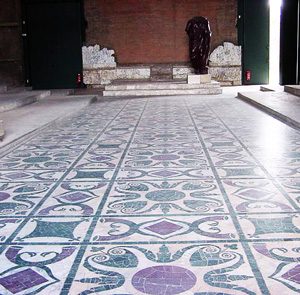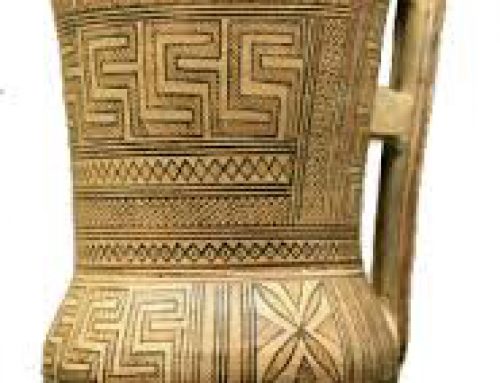
What is marble? A Cycladic figurine from Ancient Greece in marble, once realistically painted.
What is marble made out of?
Marble is metamorphic limestone . That is, marble is a metamorphic rock made out of a sedimentary rock called limestone.
What is limestone?
Metamorphic rocks
All our geology articles
And then limestone is a rock made from the shells of billions of tiny sea creatures that died and fell to the bottom of the ocean, pressed together.
More about the tiny seashells
Sedimentary rocks
Often if you look closely at limestone, you can see traces of the shells. In the 800s AD, ibn Sina in Iran was able to see from those shells that limestone must be billions of years old: so old that the weight of water pressed shells into limestone rock at the bottom of the ocean, and then the oceans moved so that the limestone was on dry land.
It takes even longer to make marble, because marble is even more pressed than limestone. But you don’t see any traces of the shells in marble, because the marble has been compressed – squashed – so much that there is nothing left of the shape of the shells. If the rock is halfway in between limestone and marble, that is travertine. It is a good building stone.
What is travertine?

What is marble? A marble quarry at Carrara, Italy, thanks to Italy Magazine
When there’s tremendous pressure on limestone for a long time, it gets squashed into marble. Usually that pressure happens when limestone is buried under a lot of other rock or an ocean. You might think that all of the marble should be at the bottom of the ocean. Then it would be hard for us to quarry it!
But no. Over billions of years, the land and the oceans move around in a process called plate tectonics. So some places that once were land are now covered by ocean, and other places that once were ocean are now up on dry land. We can get to the marble when it is on dry land, and carve it out of the ground.
What is plate tectonics?
Why do people use marble for buildings?

Native American Cherokee statues from Etowah (now northern Georgia), carved out of marble
Marble is more beautiful than limestone and tougher. If you build something out of marble, it will last longer than limestone.
But when you first cut it out of the ground, marble is pretty soft (for a rock!) and easy to carve. At least, it is easier to carve than harder rocks like granite or basalt! So people like to use marble for buildings and for statues. But marble is also rarer than limestone is, and more expensive.
A marble building: the Parthenon
How did people quarry marble without power tools?
In the ancient world, quarry workers (many of them enslaved), used hand tools to quarry marble. The quarry workers had a lot of different methods. They used iron saws, pouring olive oil or water over the cut to keep it from overheating and melting the blade. Or, they drove wedges into little cracks in the marble, and then pounded the wedges further in with mallets until the marble split.
What is a wedge?
Iron and ironworking
Where does olive oil come from?
Another method was to make a groove and rub sand into the groove with wooden paddles, over and over again until the sand wore down the marble and cut off a piece.

What is marble? The patterned marble floor of the Roman Senate’s meeting room
Does marble come in different colors?
A lot of marble is white, but marble can come in all different colors. The color depends on what other elements are in the limestone. These colors were not usually in the original seashells. The colors got mixed in with the seashells when the limestone was forming.
Iron and rust
What is magnesium?
What is sulphur?
Sometimes the color comes from iron, rusted red. Sometimes it comes from magnesium. Magnesium makes the marble green. Sulphur can mix with limestone to make yellow marble.
Greek Archaic statues
In ancient Greece and Rome, people used marble (especially white marble) to make statues. They cut colored marble in patterns to make hard floors that would last a long time.
Imperialism and marble floors
Different colors of marble came from different parts of the Roman empire. In the patterned marble floor of the Roman Senate building in the Roman forum, for example, the purple came from Egypt. Egypt was a far-away province of the Roman Empire.
So this was also a way of showing off. The architects were pointing out how powerful Rome was, that the Senate could bring stone from all these far away places that Rome had conquered.
Carving a marble statue
Marble revetments
Sometimes people also used marble in thin sheets on the walls of fancy buildings like churches or palaces, to make a brick wall look fancier. We call that a revetment. When marble was too expensive, people used travertine, or limestone, or they used plaster frescoes on their walls that were painted to look like marble.
What is a fresco?
Roman architecture

Here’s a place where some of the marble is still in place on the wall of the palace of the Roman emperors.
Famous buildings that use marble
For example, the Athenians built the Parthenon entirely of marble – that was very expensive. It was so expensive that it started the Peloponnesian War.
Peloponnesian War

First Style Roman wall painting (now in the Louvre): a plaster wall painted to look like marble
But medieval bishops built Notre Dame cathedral in Paris of limestone (partly because there isn’t as much marble near Paris). The Colosseum in Rome is built of brick and travertine, with marble only for the sculpture and the seats. Travertine is also made out of squashed limestone, but it’s limestone that has not made it all the way to being marble. So travertine is more expensive, and more beautiful, than limestone, but not as good as marble.
Domitian’s palace in Rome is brick, but with thin sheets of marble covering the brick walls. That saved money because they only needed a little marble instead of huge expensive piles of it. And many houses in Pompeii have only plaster walls painted to look like marble.
Marble mosaic pavements

A marble floor mosaic: Musicians playing at gladiatorial games, from a floor mosaic in Tripoli (Libya), in North Africa
Another popular way to use marble was in mosaic pavements. A mosaic pavement is made of thousands of small cubes of marble, or other stones, or glass, of different colors and arranged to make a picture.
(More about mosaic pavements)

A mosaic floor from the Roman baths of Caracalla, in Rome.
People started to make simple mosaic pavements in ancient Greece, but in the Roman Empire, some people got to be rich enough to have really fancy mosaic floors in their houses or palaces. Roman architects also put mosaic floors in big public buildings, where everybody could enjoy them. Mosaic floors took hundreds of hours of work to make – mostly the work of enslaved people.
So what is marble? Did this article answer your questions? Let us know in the comments!
Famous statues in marble

Indian relief carving from Amaravati. Museum caption: Drum-frieze from Amaravati, 3rd century. Palnad marble, 37.5 x 134.75 x 7 cm. London, British Museum, 1880,0709.90.
Because it was beautiful and easy to carve, sculptors also liked to use marble to make statues. Marble is a compressed stone, so there aren’t really any air holes in the stone. Pressure squeezed out all the spaces. So you can carve marble with a lot of detail, and a very smooth finish, with no bumps in it. Ancient sculptors didn’t leave their statues just marble; they liked marble’s smooth finish because it was easy to paint on, to make the statue look just like a real person.

Venus of Morgantina, from Sicly, with limestone robes and imported marble head and arms
On the island of Sicily, where there wasn’t any good marble, so you had to bring it in by ship, the artists made do with limestone for most of the statue. But even in Sicily, they paid high prices to import good marble for the heads and hands of their statues, so they would look smooth and beautiful.

Marble statue of the Laocoon: being strangled by snakes
A lot of artists from ancient Europe, Asia, and north Africa worked in marble. One famous marble statue from ancient Rome is the Laocoon, showing the Greek prophet Laocoon and his sons being strangled by snakes.
Other marble statues are the statue of Kleobis and Biton from Archaic Greece, the Discobolos from Classical Greece, and the Apoxyomenos from Hellenistic Greece.
All of these ancient marble statues were not originally meant to be white. They were painted to look natural, with the skin brownish or pinkish, and the hair blond or brown, and the snakes green.
What happened to all the marble?

A marble statue of the boddhisatva Guanyin, from Song Dynasty China (1091 AD)
Even though there were thousands of marble statues in ancient Greece and Rome, and many buildings of marble, or with marble decoration, there is very little of it left. Why is that? Marble is stone, and it’s pretty tough. It didn’t just all disappear.
No, but people destroyed it. In the Middle Ages, people tore the statues down and pulled the marble buildings apart. They burned the marble in lime kilns to make lime. You mix lime with powdered clay to make cement. Then you mix the cement with sand to make concrete.
More about cement
What is concrete?
People used cement to glue stones together to build their houses. They didn’t like having all these ruined buildings and old statues to the old gods around anymore. Now they were Christians (in Europe) and Muslims (in Africa and Asia) so they were happy to burn the old statues all up to make cement, and build new buildings.
Marble in the Middle Ages

Dome of the Rock Mosque, Jerusalem
But people kept right on building in marble, even as they were burning up the marble from antiquity. In the Middle Ages, Umayyad architects built the Dome of the Rock in Jerusalem out of marble.
The Dome of the Rock
The Pisa Duomo
Florence Duomo
Then the people of Pisa built their Duomo out of gray and white marble, with colored marble panels. In Florence, the cathedral was dramatically striped in black and white marble, with bits of colored marble too.
Marble in the Renaissance

Michelangelo’s David
And in the Renaissance, the great sculptor Michelangelo carved new statues out of the beautiful white Carrara marble that people quarried near Florence. He was imitating the beautiful marble statues from ancient Greece and Rome.
But Michelangelo didn’t know that those ancient statues had been painted. He thought all the ancient statues had just been white. So he left all his own statues plain white too! Today, that seems more normal to us, and painted statues seem surprising and different.
Learn by doing: is there any marble in your house? Can you find any in your neighborhood? At your school?
A project to make your own mosaic
More about limestone
Bibliography and further reading about ancient marble:
DK Eyewitness Guides: Building, by Philip Wilkinson (2000).
Geology: A Golden Guide from St. Martin’s Press, by Frank Rhodes (2001).
Ancient marble quarrying and trade (1986). A collection of papers by specialists, for specialists, about marble in ancient Greece and Rome.




